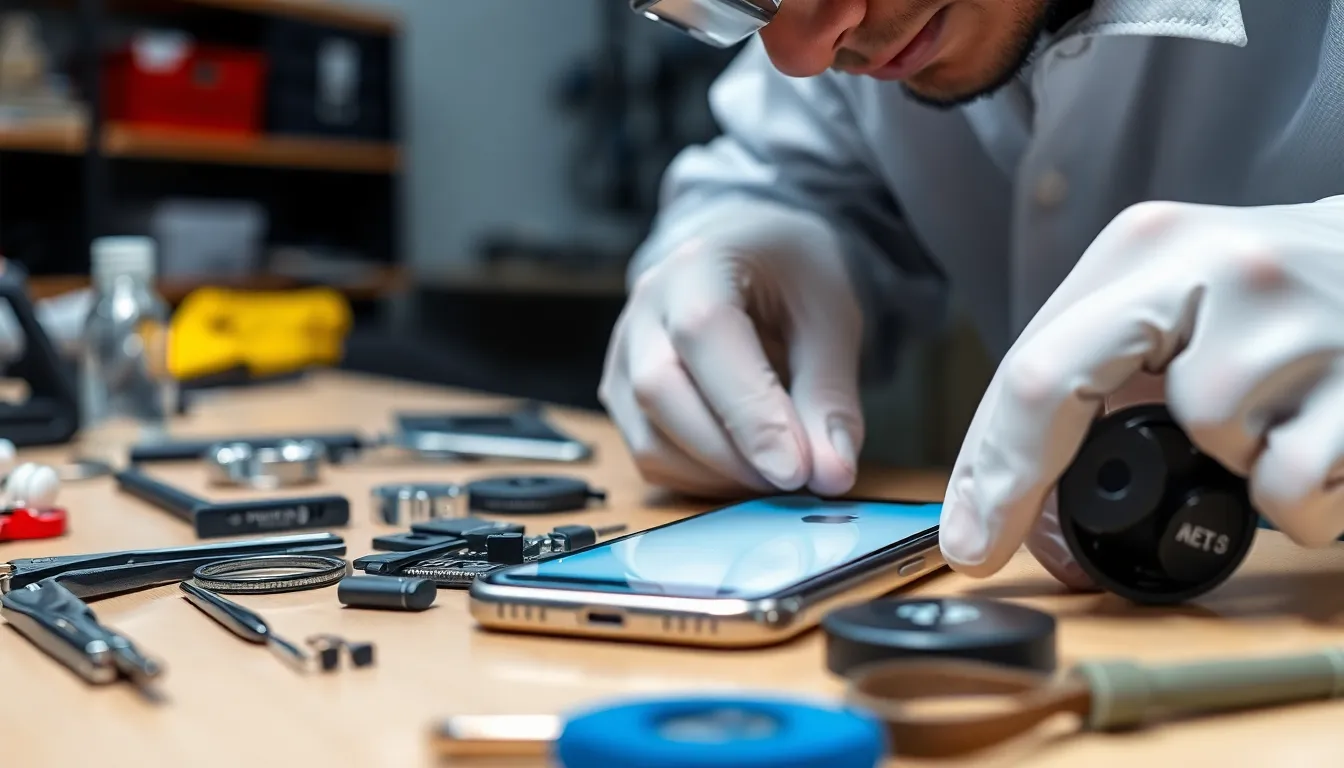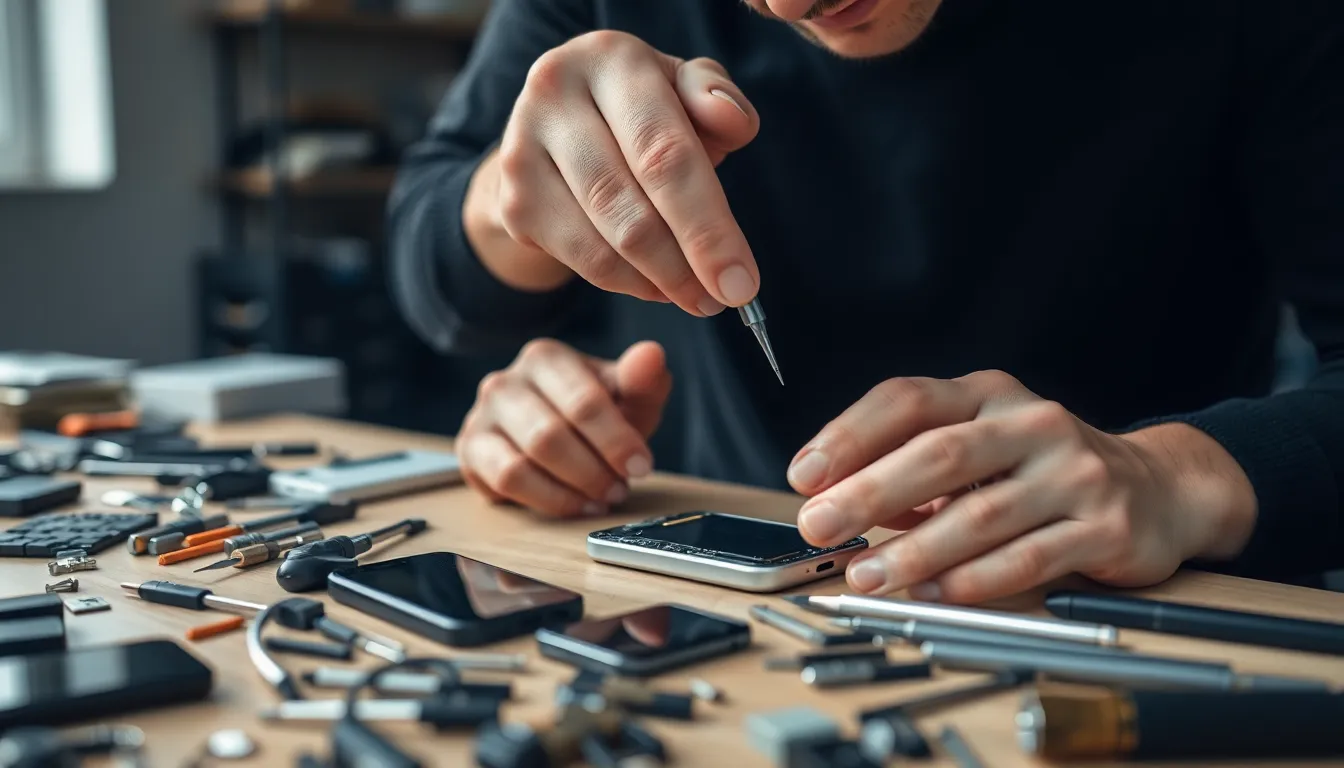Picture this: you’re all set for a day of adventure, but your iPhone’s charging port decides to throw a tantrum. Suddenly, that trusty device is as useful as a brick. So, how much does it cost to fix a charging port on an iPhone? Spoiler alert: it’s not as simple as picking up a latte.
Table of Contents
ToggleOverview of iPhone Charging Port Issues
A malfunctioning iPhone charging port can lead to various problems. Users often report issues such as slow charging or inability to connect to a power source. Dust and debris accumulation commonly contributes to these issues. Even moisture exposure can affect charging performance, resulting in inconsistent connections.
Some problems may require simple cleaning of the charging port. Other cases might necessitate more extensive repairs. A damaged port can prevent the device from receiving power entirely. Additionally, signs of wear like loose connections often indicate a need for a more in-depth inspection.
The complexity of iPhone designs can complicate repairs. Attempting to fix the charging port without proper tools or expertise can lead to further damage. It’s essential to consult a professional for reliable service. Repair shops often offer diagnostic services that can pinpoint the source of charging problems.
Repair costs vary based on the model and severity of the issue. On average, users should expect repair expenses from $50 to $150. The price can increase if other components, like the battery, require attention. Choosing original parts during repair may lead to higher costs, but it can enhance longevity and performance.
Considering the intricacies of iPhone components, preventative measures can help avoid future issues. Regular cleaning of the port promotes better connectivity and reduces wear. Staying vigilant can save users both time and money in the long run.
Factors Affecting Repair Costs

Repair costs for a malfunctioning iPhone charging port depend on several important factors. Understanding these can clarify why prices vary widely.
Type of iPhone Model
Different iPhone models impact repair costs significantly. Older models typically feature simpler designs, resulting in lower repair expenses, often ranging from $50 to $75. Newer models, such as the iPhone 12 or 13, incorporate more advanced technology, increasing potential repair costs to $100 or more. Device rarity also influences pricing; models that are less common may incur higher charges due to limited parts availability. Variances in repair costs also arise depending on the local market and service provider.
Nature of the Damage
The extent of damage directly affects repair prices. Minor issues, like dirt or debris blocking the port, can often be resolved through cleaning, costing between $20 and $40. Significant damage, such as a cracked charging port or severe internal issues, requires more extensive repairs, which can lead to costs of $100 or more. Additional concerns, like water damage, typically need comprehensive diagnostic evaluations and repairs, further increasing the overall expense. Addressing these issues promptly helps reduce long-term costs and complications.
Repair Options Available
Various repair options exist for fixing an iPhone charging port. Users can choose between authorized service centers and third-party repair shops based on preference and budget.
Authorized Service Centers
Authorized service centers provide reliable repairs using genuine parts. Technicians trained by Apple handle repairs, ensuring quality and adherence to warranty standards. Repair costs typically range from $100 to $150, depending on the iPhone model and damage extent. Appointments often can be made online for convenience. Warranty protection might cover repairs, so checking on warranty status is advisable before proceeding.
Third-Party Repair Shops
Third-party repair shops often offer competitive prices for charging port fixes. Users might find costs ranging from $50 to $100, appealing to those seeking budget-friendly options. Services often include fast turnarounds; some shops even offer same-day repairs. Not all shops provide warranties, so verifying the shop’s reputation and customer reviews helps ensure reliable service. Though repairs may use non-genuine parts, many third-party options can fulfill users’ needs effectively.
Estimated Costs for Repair
Repairing an iPhone charging port involves several cost factors. Users can expect varying prices based on model and damage extent.
Average Price Range
Repair costs for a charging port typically range from $50 to $150. Authorized service centers charge between $100 and $150 for repairs, which cover genuine parts and reliable service. Third-party repair shops offer more competitive rates, ranging from $50 to $100, appealing to budget-conscious users. Access to lower-priced options exists, but users need to carefully review the reputation of these shops.
Additional Costs to Consider
Users might encounter additional expenses during the repair process. Costs may arise from diagnostic fees, which authorized centers often charge upfront, typically ranging from $20 to $50. If hardware components are damaged beyond the charging port, further repairs could lead to additional charges. Warranty considerations also influence costs; unauthorized repairs may void existing warranties, potentially incurring future expenses. Lastly, users should factor in the possibility of paying for parts if they choose a third-party service with lower repair rates.
DIY Repair: Pros and Cons
DIY repair offers potential cost savings. Many users attempt to fix charging ports to avoid professional service fees, which can range from $50 to $150. Repairing it yourself can be fulfilling and educational. Users gain hands-on experience and better understanding of their devices.
However, DIY repairs come with risks. Complex iPhone designs present challenges, increasing the likelihood of causing further damage. Unintentional harm could complicate the issue, leading to more expensive repairs. Without proper tools and expertise, users might find themselves stuck or making mistakes.
Time can also be a factor. DIY repairs often require extensive research and trial and error. Many repair guides exist but not all are reliable or tailored to specific iPhone models. Inexperienced users may spend hours attempting to resolve the issue without success.
Warranties might become void after unauthorized repairs. Engaging in DIY fixes can nullify existing warranties, which means future service costs won’t be covered. Users must weigh the potential savings against the risk of losing their warranty protection.
Moreover, sourcing quality parts is crucial. Low-quality components could lead to recurring issues or affect overall device performance. Authorized service centers guarantee genuine parts, while third-party shops may vary in quality.
Evaluating personal skills is essential. Skilled individuals may navigate DIY repairs with confidence, while others might struggle. Users should consider their comfort level with technology before deciding on a DIY approach. Each option has its pros and cons, requiring careful thought before proceeding.
Repairing an iPhone charging port can be a significant investment depending on the model and extent of the damage. Users should weigh their options carefully between authorized service centers and third-party shops to find the best fit for their budget and needs. Regular maintenance can help prevent issues and reduce repair costs in the long run. Whether opting for professional help or considering a DIY approach, understanding the potential risks and expenses involved is crucial. Ultimately, being proactive about device care can lead to a more reliable iPhone experience.



